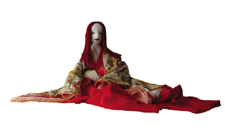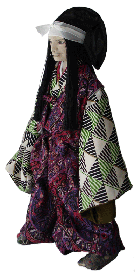Opening Ceremony - September 15,
2006 , 3pm - 6pm:
Artist will attend the opening ceremony
Art
Beatus
(Vancouver) Consultancy is pleased to present
“The Tale of the Heike”, a
Japanese epic portrayed through the magic of dolls
created by local doll-artist, Tomoka Ike. The
exhibition will begin Friday, September 15 with an
opening reception
starting at 3pm and ending at 6pm. The
public are welcome and are encouraged to attend; the artist will also
be in
attendance. On display will be 19 dolls,
each representing a major character from “The Tale of the Heike”, a story
which
takes place in the mid to latter part of 12th century Japan. Ike immigrated to Canada just over 25 years
ago; shortly after her arrival, she began making dolls.
Unique and special, her work is exquisite –
the luxurious fabrics used to dress the dolls and the finely detailed
facial
expressions clearly reflect the personality of any character she
creates. In working with the “Heike” theme, she has
interpreted how she sees these historical figures and has made them her
own.
“The Tale of the Heike” is an epic
account of the
struggle between the Minamoto and Taira clans for control of Japan in
the
conflict known as the Genpei War. Heike
refers to the Taira clan, ‘hei’ being an alternate reading of the kanji
character for Taira. The Taira are
portrayed to have been consumed with so much hatred that they sow the
seeds of
their own destruction and are eventually defeated by a revitalized
Minamoto. Buddhist themes are imbued
throughout the story – a moral lesson about the attachment to worldly
desires.
Though
it is a tale
of war, it includes many love stories
and remarkable women who sought solace and salvation in Buddhism after
meeting
their sorrowful fate. The theme of
impermanence is a prominent element in the tale as captured in the
famous
opening paragraph, “The sound of the
Gion Shôja bells echoes the impermanence
of all things; the color of the sala flowers reveals the truth that the
prosperous must decline. The proud do not endure, they are like a dream
on a
spring night; the mighty fall at last, they are as dust before the wind.”
(Helen Craig McCullough’s translation).
The
story was designed to be told in a series of nightly
installments and was compiled from a collection of oral recitations,
later
transcribed in the 14th century. The
author is said to have been one of the courtiers who witnessed the tale
told
through blind monks who travelled throughout the Japanese countryside
reciting
epic poems while playing the biwa, a lute-like instrument.
The tale is roughly divided into three parts;
the main figure of the first section is the arrogant, evil and ruthless
Taira
no Kiyomori; the second section focuses on 2 key players, Minamoto No
Yoritomo
and his cousin Yoshinaka. The central
character in the third section is the amazing samurai, Minamoto no
Yoshitsune
and the fall of the Taira clan. “The
Tale of the Heike” is considered one of the great classics of
medieval Japanese
literature and is said to have influenced the psychic landscape of
Japanese
people as seen in many areas of artistic expression.

